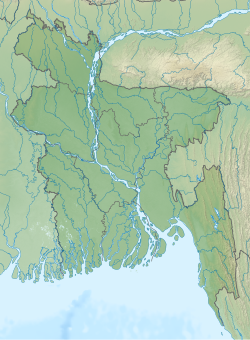The Nayabad Mosque, also known as the Noyabaad Mosque, is a mosque located in the Nayabad village in Kaharole Upazila, in the Dinajpur District of Bangladesh, beside the Dhepa River.[1] It was built in 1793 CE during the rule of Mughal ruler Shah Alam II.[2] Locals believe it was built by the Muslim architectural workers who came from Persia[3] to build the Kantajew Temple for their own use.
| Nayabad Mosque | |
|---|---|
 | |
| Religion | |
| Affiliation | Islam |
| Ecclesiastical or organizational status | Mosque |
| Status | Active |
| Location | |
| Location | Nayabad, Kaharole Upazila, Dinajpur District |
| Country | Bangladesh |
Location of the mosque in Bangladesh | |
| Geographic coordinates | 25°46′55″N 88°39′31″E / 25.7819°N 88.6586°E |
| Architecture | |
| Type | Mosque architecture |
| Style | Mughal |
| Completed | 1793 CE |
| Specifications | |
| Length | 12.45 m (40.8 ft) |
| Width | 5.5 m (18 ft) |
| Dome(s) | Three |
| Minaret(s) | Four |
Architecture
editThe building is oblong, with three entrances on one side. The roof has three domes, and at each corner an octagonal minaret with a cupola (two of the cupolas are now missing). The outer dimensions of the building are 12.45 metres (40.8 ft) by 5.5 metres (18 ft), with walls that are 1.1 metres (3.6 ft) thick.[1]
See also
editReferences
edit- ^ a b Sitara, Sania (2012), "Nayabad Mosque", in Islam, Sirajul; Jamal, Ahmed A. (eds.), Banglapedia: National Encyclopedia of Bangladesh (Second ed.), Asiatic Society of Bangladesh
- ^ "Nayabad Mosque: A great Mughal architecture". Daily Sun. Retrieved 2020-04-27.
- ^ "Nayabad Mosque". Nayabad Mosque | theindependentbd.com. Retrieved 2020-04-27.
External links
editMedia related to Nayabad Mosque at Wikimedia Commons
